
Brown rot is an infectious disease that mainly affects tomatoes and potatoes infested. The trigger is the fungus "Phytophthora infestans". Can brown rot be combated by treating and disinfecting the soil around affected plants?
In a nutshell
- mainly affects soil from tomatoes, potatoes and other nightshade plants
- Fungus grows on plant parts above ground
- Replacing the soil only makes sense for potted plants
- Treat soil more effectively with home remedies instead
- Use plant manure and calcium cyanamide
Table of Contents
- detect brown rot
- Treat/disinfect infested soil
- exchange earth
- Slow down and dry out fungal pathogens
- Treatment with plant strengthening
- Calcium cyanamide for disinfection
- frequently asked Questions
detect brown rot
The brown rot fungus first affects the soil around susceptible nightshades. Because it needs moist conditions for its existence, the soil is correspondingly wet. This ensures typical identification features of a fungal infestation:
- increasing formation of white-grey spore carpets
- fallen leaves are also affected
- musty odor rises

The fungus also pulls up from the soil on the above-ground parts of the plant. The fungal infestation on the ground is often not visually noticeable, so brown rot can only be recognized by looking at the plants. The following visible features that indicate an infestation:
- Formation of white-grey fungi on the underside of leaves
- Wood turns brown
- brown spots on leaves, stems and fruits
- in advanced stages black leaf discolouration, followed by wilting and death
- Woody shoots with cross-cracked wood structures
- Plant parts lose strength and mass
Treat/disinfect infested soil
There are several methods to treat or disinfect the soil to combat brown rot. However, not all measures make sense in principle.
exchange earth

A simple variant is to simply dig up the infested soil and replace it with fresh, "clean" substrate. Depending on the amount of soil to be exchanged, however, this measure is often tantamount to transplanting. Especially shortly before and during fruit formation, this stress could have a negative impact on the harvest result. In addition, roots could be damaged, which in the worst case could result in the affected plants dying.
Although soil replacement is a quick fix for getting rid of brown rot pathogens, it also offers this practice is not a hundred percent guarantee that all existing pathogens will actually be eliminated to have.
Useful for pot/tub plants
The situation is different for plants in pots and tubs. Here the infested soil is clearly limited in quantity and therefore completely interchangeable. As a result, the chance of being able to dispose of all pathogens by changing the soil is very high. Important is but that you really die entire earth, i.e. H. also those in the root area, remove completely. However, this measure is only suitable as long as the plants are not yet in the middle of flowering and/or fruit development.
Slow down and dry out fungal pathogens

Instead of a soil change, there is a lot of time and labor that can be saved if you take the right measures to stop and dry out the fungus. This deprives the pathogens of their basis for survival and thus prevents the infection from spreading. That's how it's done:
- loosen soil, to ensure better permeability
- thickness mulch layer spread on infested soil
- for rain protection ensure that the soil dries
- Cut off the lower leaves up to the first fruits and all parts of the plant with visible spores
- Distancebetween neighboring plants that are too close together for better air permeability
Tip: This method of treating the fungal disease is ideal for gentle control. However, you should check plants and soil regularly and early on for brown rot in order to be able to react as quickly as possible and prevent serious damage to the plants.
Treatment with plant strengthening
There are effective home remedies against brown rot that can be used to effectively treat the soil.
vegetable manure
Plant manure serves to strengthen plants by optimizing their defenses. In the case of susceptible nightshades, you should spread the liquid manure before sowing/planting so that the plants benefit from it right from the start.

an effective one nettle manure make it like this:
- 1 kilogram of fresh or 200 grams of dried nettles Per 10 liters of water
- Cut into small pieces, place in the container and stir well
- container close and stir once a day
- 10 to 14 days leave to ferment
- for watering mix with water in a ratio of 1:50
- Also used for prophylaxis every 3 to 4 weeks during the season
Calcium cyanamide for disinfection
Calcium cyanamide has disinfecting properties and is ideal for use in addition to one of the control and treatment methods already mentioned. Particularly useful is the incorporation of calcium cyanamide into the soil for soil preparation and before planting. Disinfection can eliminate remaining and new early-stage brown rot pathogens in the soil. The dosage can be found in the respective manufacturer's information. It is important that you Keep soil well moist after application.
A notice: Do not put calcium cyanamide in the soil where new plantings are located as they can suffer burns up to and including life threatening. Administer the active ingredient at least two weeks before the planned planting date.
frequently asked Questions
It depends on the climate and soil conditions. In hot, dry weather, the fungus dies off after a few hours. Otherwise, it even overwinters in the ground and spreads again the following year from around 16 degrees Celsius.
When sowing/planting, ensure sufficient planting distances. Avoid direct proximity to other nightshade plants. Adhere to the crop rotation and waiting times of 3 to 4 years before planting nightshade plants in the same spot in the bed again. Only water the soil, never the leaves. Watering in the morning promotes faster drying of the soil surface. Care for your plants properly according to their needs.
Ideal conditions for brown rot are given when temperatures are above 16 degrees Celsius and there is significant soil moisture for a period of more than ten hours. In addition, locations promote fungal infestation if moisture can persist for a long time due to insufficient air circulation or soil compaction.


